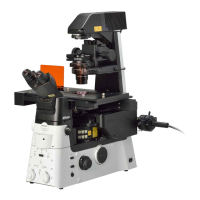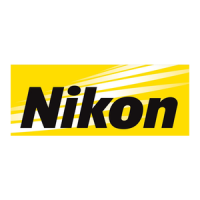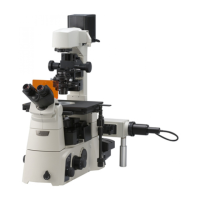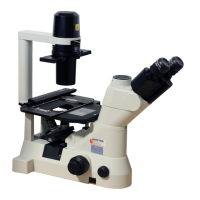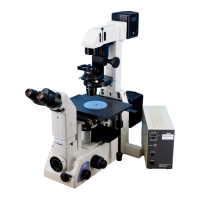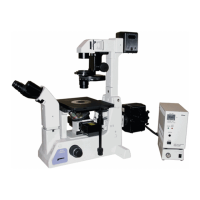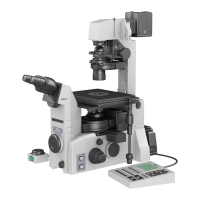Chapter 4 Microscopy Techniques
97
4.5 Details of Diascopic Dark-field (DF) Microscopy
4.5.1 Principles of DF Microscopy
DF microscopy is a technique for improving the
contrast of unstained specimens using oblique
illumination.
Unlike other diascopic microscopy techniques (Ph or
DIC) that form images of dark specimens on a bright
background, this microscopy technique enables
bright specimens to be visualized in high contrast on
a dark background.
Visualizing scattering objects
The illumination that has reached the specimen is
divided into two types: bright transmitted light, having
passed through non-scattering parts of the specimen,
and light scattered and diffracted by the specimen.
The intensity of scattering can be observed as
brightness/darkness of the light by eliminating bright
transmitted light from the optical system and by
extracting only scattered and diffracted light.
DF microscopy optical system
The light emitted from the light source is annularly
narrowed by the annular diaphragm. It passes
through the periphery of the DF condenser lens, and
then obliquely illuminates the specimen. DF
microscopy uses an objective of lower NA than a DF
condenser lens (or objective with diaphragm), to
form a DF image utilizing only light scattered from
the specimen passing through the objective.
Optical path of DF microscopy
Advantages of DF microscopy
• The DF microscopy enables observation of the low-contrast specimens and micro-objects below the
diffraction limit (such as flagellum and gold colloid).
Disadvantages of DF microscopy
• Objectives with a smaller number of apertures are used, so resolution is limited.
• This microscopy technique is not suitable for specimens having multiple scattering elements, such as thick
specimens.
4.5.2 Optical Elements Required for DF Microscopy
DF microscopy uses the following components.
Condenser turrets or condenser sliders are not used.
• Objectives with NA smaller than the minimum NA of the condenser, or objectives with a diaphragm (10x or
more for the dry-type condenser lens, 20x or more for the oil-type condenser lens)
• Dark-field condenser adapter (TI-DF)
• Darkfield condenser (darkfield condenser Oil or darkfield condenser Dry)
• T-CHNA High N.A. common condenser lens unit (optional)
DF condense
nnular
diaphragm
Objective
Illumination
Illumination Illumination
